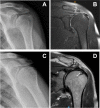Return to Sports After Arthroscopic Treatment of Rotator Cuff Calcifications in Athletes
- PMID: 27826596
- PMCID: PMC5084521
- DOI: 10.1177/2325967116669310
Return to Sports After Arthroscopic Treatment of Rotator Cuff Calcifications in Athletes
Abstract
Background: Arthroscopic treatment of calcific deposits of rotator cuff tears has been described with successful results in the general population. However, despite the high frequency of this condition, there is no information in the literature regarding arthroscopic treatment of rotator cuff calcifications in athletes.
Purpose: To analyze the time to return to sport, clinical outcomes, and complications of complete arthroscopic removal of intratendinous calcific deposits and repair of the tendon lesion without acromioplasty in athletes.
Study design: Case series; Level of evidence, 4.
Methods: This study retrospectively evaluated 24 consecutive patients with a mean age of 36.2 years. The mean follow-up was 59 months (range, 24-108 months). Patients completed a questionnaire focused on the time to return to sport and treatment course. Pre- and postoperative functional assessment was performed using the Constant score and University of California Los Angeles (UCLA) score. Pain was assessed by visual analog scale (VAS). Radiographs and magnetic resonance imaging (MRI) were performed to evaluate the recurrence of calcifications and the indemnity of the supraspinatus tendon repair.
Results: Of the 24 patients, 23 (95.8%) were able to return to sports; 91.3% returned to the same level. The mean time to return to play was 5.3 months (range, 3-9 months): 26% of patients (6/23) returned to sports in less than 4 months, 61% (14/24) returned between 4 and 6 months, and 13% (3/24) returned after the sixth month. The mean Constant score increased from 26.9 preoperatively to 89.7 postoperatively (P < .001), and the UCLA score increased from 17.3 preoperatively to 33.2 postoperatively (P < .001). Significant improvement was obtained for pain (mean VAS, 8.4 [before surgery] vs 0.6 [after]; P < .001). The overall majority (91.6%) of patients were satisfied with their result. MRI examination at last follow-up (79% of patients) showed no tendon tears.
Conclusion: In athletes with calcifying tendinitis of the supraspinatus tendon with failed nonoperative treatment, complete arthroscopic removal of calcific deposits and tendon repair without acromioplasty results in significant pain relief and improvement in functional outcomes. Most patients return to the same level of proficiency regardless of the type of sport and the level of competition before injury, with 91.6% of patients satisfied with their results.
Keywords: arthroscopy; athletes; calcifying tendinitis; return to sports; rotator cuff.
Conflict of interest statement
The authors declared that they have no conflicts of interest in the authorship and publication of this contribution.
Figures

Similar articles
-
Arthroscopic Removal and Rotator Cuff Repair Without Acromioplasty for the Treatment of Symptomatic Calcifying Tendinitis of the Supraspinatus Tendon.Orthop J Sports Med. 2015 Apr 7;3(4):2325967115577957. doi: 10.1177/2325967115577957. eCollection 2015 Apr. Orthop J Sports Med. 2015. PMID: 26665052 Free PMC article.
-
Return to recreational sport and clinical outcomes with at least 2years follow-up after arthroscopic repair of rotator cuff tears.Orthop Traumatol Surg Res. 2016 Sep;102(5):563-7. doi: 10.1016/j.otsr.2016.02.015. Epub 2016 Apr 28. Orthop Traumatol Surg Res. 2016. PMID: 27133977
-
Long-Term Outcomes After In Situ Arthroscopic Repair of Partial Rotator Cuff Tears.Arthroscopy. 2019 Mar;35(3):698-702. doi: 10.1016/j.arthro.2018.09.026. Epub 2019 Jan 10. Arthroscopy. 2019. PMID: 30638977
-
Return to Sport After Arthroscopic Rotator Cuff Repair: Is There a Difference Between the Recreational and the Competitive Athlete?Am J Sports Med. 2020 Jan;48(1):252-261. doi: 10.1177/0363546519825624. Epub 2019 Mar 11. Am J Sports Med. 2020. PMID: 30855979
-
Impact of rotator cuff surgery on postoperative sporting activity.J Sports Med Phys Fitness. 2018 Apr;58(4):480-488. doi: 10.23736/S0022-4707.16.06559-2. Epub 2016 Oct 20. J Sports Med Phys Fitness. 2018. PMID: 27763580 Review.
Cited by
-
Criteria for Return-to-Play (RTP) after Rotator Cuff Surgery: A Systematic Review of Literature.J Clin Med. 2022 Apr 17;11(8):2244. doi: 10.3390/jcm11082244. J Clin Med. 2022. PMID: 35456339 Free PMC article. Review.
-
Return-to-Sport Criteria After Upper Extremity Surgery in Athletes-A Scoping Review, Part 1: Rotator Cuff and Shoulder Stabilization Procedures.Orthop J Sports Med. 2021 Aug 6;9(8):23259671211021827. doi: 10.1177/23259671211021827. eCollection 2021 Aug. Orthop J Sports Med. 2021. PMID: 34395687 Free PMC article.
References
-
- Allain J, Goutallier D, Glorion C. Long-term results of the Latarjet procedure for the treatment of anterior instability of the shoulder. J Bone Joint Surg Am. 1998;80:841–852. - PubMed
-
- Ark JW, Flock TJ, Flatow EL, Bigliani LU. Arthroscopic treatment of calcific tendinitis of the shoulder. Arthroscopy. 1992;8:183–188. - PubMed
-
- Balke M, Bielefeld R, Schmidt C, Dedy N, Liem D. Calcifying tendinitis of the shoulder: midterm results after arthroscopic treatment. Am J Sports Med. 2012;40:657–661. - PubMed
-
- de Witte PB, Selten JW, Navas A, et al. Calcific tendinitis of the rotator cuff: a randomized controlled trial of ultrasound-guided needling and lavage versus subacromial corticosteroids. Am J Sports Med. 2013;41:1665–1673. - PubMed
LinkOut - more resources
Full Text Sources
Other Literature Sources

